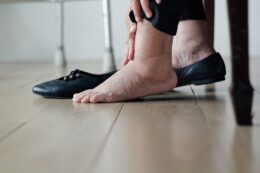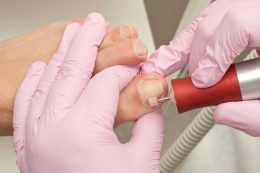Tagged with #podiatrist …
Most Common Aging-Associated Foot Problems and How to Manage Them
Just like the rest of our bodies, our feet also undergo a range of changes as we age gracefully. The aging process can bring about several health conditions that can impact our mobility and overall quality of life. You can take proactive steps to maintain healthy feet. Read on to learn more about the most common foot problems that accompany the golden years and the potential treatment options.
Arthritis
One of the prevalent foot problems among older adults is arthritis. It is a health problem that involves soreness and inflammation in the joints. This condition makes walking and performing daily activities challenging due to pain. Proper footwear, exercises, and medication can help manage this foot problem.
Plantar Fasciitis
It is caused by inflammation of the plantar fascia, a thick tissue band that supports the foot arch. This condition is often caused by repetitive strain and can result in heel pain and discomfort due to weakened tissue. Stretching exercises, orthotic inserts, and physical therapy can help relieve its symptoms.
Bunions
This condition refers to bony protrusions that develop at the base of the big toe. Bunions can be painful and cause difficulty in finding comfortable footwear. Aging can contribute to the development of bunions due to changes in foot structure and joint alignment. Wearing shoes with the right fit and using orthotic devices can help manage bunions and reduce discomfort.
Corns and Calluses
These refer to the thickened areas of skin that commonly develop on the feet. Corn and calluses often caused by pressure from ill-fitting shoes. Our skin gradually becomes thinner and loses its elasticity as we grow older. To prevent and treat corns and calluses, it’s important to exfoliate regularly, moisturize, and wear suitable footwear.
Peripheral Neuropathy
This condition refers to nerve damage that affects the peripheral nerves, leading to symptoms such as numbness, tingling, and burning sensations in the feet. Aging, along with conditions like diabetes, can increase the risk of developing peripheral neuropathy. Apart from maintaining good hygiene, individuals should seek medical attention whenever they experience any unusual sensations in their feet.
Conclusion
As we journey through life, our feet bear the brunt of it all. It is crucial to prioritize our foot health to ensure our mobility and overall health. Familiarizing ourselves with the foot problems that come with aging can help us take measures to prevent them and seek the necessary treatment if required. Aside from wearing proper and comfortable footwear, consulting with healthcare professionals can help ensure healthy and pain-free feet. Count on Thomas Podiatry & Associates for exceptional foot care, allowing you to enjoy your golden years with assurance. Contact us today to schedule a consultation with our podiatrist.
How To Determine if You Have Plantar Warts
Plantar warts are small skin growths typically found on the soles of the feet. These spots are caused by the human papillomavirus (HPV) when they enter through cuts or breaks in your skin. This foot condition may cause pain and discomfort, so it’s best to treat it immediately. To find out if you have plantar warts, here are some signs and symptoms to look out for:
• Appearance
You may recognize a plantar wart from its rough, fleshy, and grainy appearance. It may also have black dots or pinpoints on the surface, called wart seeds, which are dried blood vessels. Having thick, hardened, or callused spots on the bottom of your foot may also be a sign of a wart. To get the right diagnosis, you can always talk to a podiatrist.
• Location
Plantar warts often develop on the weight-bearing areas, such as the heel or ball of your feet, making standing or walking quite uncomfortable. Sometimes, warts may also appear on, around, or between your toes.
• Symptoms
Although some people don’t experience painful symptoms with plantar warts, others do. The pain is usually described as a sharp burning sensation, which can also be accompanied by tenderness. Because of this, standing, walking, and going about your daily routines can become difficult over time.
How Can You Treat Plantar Warts?
While plantar warts often go away on their own, it’s still best to have them removed immediately, especially if you have an autoimmune disease or a compromised immune system. Doing so also prevents the infection from worsening or spreading further.
Some common plantar wart treatments include over-the-counter medications, prescription topical creams, freezing, laser therapy, or even surgery. The type of procedure will depend on your overall condition. So, if you have developed a plantar wart, it’s best to consult a foot doctor for a proper diagnosis and a personalized treatment plan.
Get in Touch With a Trusted Podiatrist
Learning how to recognize plantar warts will help you get prompt treatment as necessary. If you suspect you have this foot condition, it’s best to see a podiatrist immediately. Contact Thomas Podiatry & Associates in Salisbury, MD for reliable podiatric services.
How To Prepare Your Home Before Foot Surgery
When symptoms of conditions like plantar fasciitis, bunions, and Achilles tendon disorders aren’t alleviated with therapy or other initial treatments, foot and ankle surgery may be necessary. Since anesthetics are used, the procedure has minimal pain and discomfort. But you will need some time to recover fully.
As your mobility may be impaired after the surgery, preparing your home before the procedure is crucial. Here are some tips to help you with recovery:
Ask for Help in Advance
After a foot and ankle surgery, moving around on your own will be tough, making simple tasks like preparing meals and cleaning the house virtually impossible. So, as soon as the procedure is scheduled, reach out to a friend or family member who can help while you’re recovering at home. Doing so will also help you focus on caring for your feet and getting as much rest as possible to ensure a smooth recovery.
Create a Living Space on the Ground Floor
Using the stairs after foot surgery poses a safety risk. So, if your bedroom is on the second level of your home, utilize the living area or an extra room on the main floor instead. Take note that there should be enough space to move around comfortably and accommodate assistive devices you might use, like crutches or walkers.
Ensure your essentials are within reach in your new living space, so you won’t have to get up too often. These include your medicine, phone, laptop, tv remote, charger, and drinks and snacks. Besides that, hazards like uneven flooring or slippery rugs should be fixed and removed to prevent risks of tripping or slipping on them. Lastly, clear pathways from clutter and install proper lighting to avoid accidents.
Stock Up on Supplies and Necessities
Since it will be difficult to go out whenever you need to after the surgery, it’s best to stock up on all the necessities beforehand. Aside from the prescribed medication and other necessary tools for your recovery, ensure you have enough food, drinks, snacks, toiletries, and other essentials usually unavailable for delivery.
Consult a Trusted and Reliable Foot Doctor
Being prepared after a foot and ankle surgery is essential to ensure a smooth and fast recovery. If you experience persistent pain or other symptoms of your foot condition, consult a podiatrist to determine if you need surgical treatment. Contact Thomas Podiatry & Associates at Salisbury, MD for more information.
4 Causes of Swollen or Inflamed Feet
Swelling and inflammation on your feet can become an inconvenience to your daily routine. Besides making walking around and doing simple tasks difficult, you may also experience pain and discomfort.
There are many reasons for getting inflamed feet, such as the warm weather or standing and walking for long periods. While some causes may not call for urgent treatment, others may come with serious complications, so it’s best to visit a foot doctor when you experience any symptoms. Here are some common causes of swelling and inflammation in your feet:
Injury
Trauma or damage to any part of your body may result in inflammation, which typically leads to swelling. Of course, your feet and ankles are no exception. Sprains, tears, stress fractures, and broken bones are some of the injuries that might cause swollen and inflamed feet. When these foot-related injuries occur, you can use rest, ice, compression, and elevation method to ease symptoms.
Blood Clot
These solid clumps of blood hamper proper blood circulation and lead to swollen feet, ankles, and even legs. A deep vein thrombosis or DVT is a condition that occurs when blood clots form deep in your veins and cause other symptoms, like foot discoloration and fever. You can reduce the risks of DVT through lifestyle changes, such as exercising more and increasing fluid intake.
Infection
Another reason for swollen and inflamed feet is infection. It can occur when you have diabetic wounds or conditions like peripheral neuropathy, which puts you at risk of foot ulcers. Despite that, other situations may lead to an infection, so it’s crucial to always maintain proper foot health.
Medication
If you take certain medications that cause fluid to collect in your feet, it is a likely cause of swelling or inflammation. These include steroids, antidepressants, and diabetes and blood pressure medication. If the swelling occurs frequently, talk to your doctor.
Consult Our Experts at Thomas Podiatry & Associates
Learning about some causes of swollen and inflamed feet is helpful if you experience it yourself. Still, it’s best to have a podiatrist check your feet’s condition to ensure the right diagnosis and treatment you need. Contact us at Thomas Podiatry & Associates in Salisbury, MD for more information about our foot care services.
Flat Feet: Its Causes and Treatments
One of the most common foot disorders is flat feet or fallen arches. This condition occurs when there is minimal to no visible arch on a person’s feet when they stand up, making their heels flatten to the ground. Although some people don’t get symptoms with flat feet, others may experience ankle or heel pain, difficulty walking, swelling, and more.
Because of this, if you have flat feet or notice any potential symptoms of this condition, it’s best to see a podiatrist. Read on to learn more.
What Causes Flat Feet?
Babies and toddlers typically have no arches in their feet as they only develop around the age of six. But, when they don’t, flat feet may occur. This condition may also be caused by genetics, as well as the following:
Obesity – Too much pressure on the feet can change their structure. So, adults with excess weight are more at risk of developing flat arches.
Foot and Ankle Injuries – Broken bones, tendon damage, and other foot and ankle trauma may cause your arches to fall, resulting in flat feet.
Rheumatoid Arthritis – This disease causes the tendons, ligaments, and joints to shift out of their usual positions and change the shape of your feet.
How Are Flat Feet Treated?
While people who don’t experience pain or discomfort won’t require flat feet treatment, those who otherwise do may be treated through various means. Depending on their condition and its severity, some treatments that can be done are:
Nonsteroidal Anti-Inflammatory Drugs (NSAIDs) – Over-the-counter pain medications, like ibuprofen, can be taken if you experience discomfort and inflammation.
Supportive Devices – Custom-made shoes, arch support inserts, and other foot orthotics help ease the pressure on your flat feet and reduce painful symptoms.
Physical Therapy – With the help of a physical therapist, specific stretches and exercises will be recommended to strengthen your muscles and manage flat feet symptoms.
Get in Touch With a Trusted Podiatrist
Having flat feet may hurt your lifestyle in some capacity. So, if you suspect that you have this foot condition or already have it and want to get treated, talk to a podiatrist near you. Reach out to our experts at Thomas Podiatry & Associates in Salisbury, MD for trusted and reliable foot care and treatment services.
When To See a Podiatrist for an Ingrown Toenail Pain
An ingrown toenail is a common foot condition that occurs when the corner of your toenail grows into the skin beside your nail. This typically affects the big toe and is characterized by pain, swelling, and, in more severe cases, bleeding.
While some ingrown toenails may be treated through home remedies, like antibiotic ointments, others may need professional care. Read on to find out when to visit a podiatrist.
There Are Signs of Infection
Most of the time, ingrown toenails don’t come with serious health complications. But if they’re left untreated for a long time, they may lead to an infection. Signs of an ingrown toenail infection include intense pain, excessive redness, bleeding, discharge of pus, and even the possibility of a fever. An untreated infection may spread to other parts of the body, so consult a foot doctor before symptoms worsen.
Home Remedies Don’t Work
If you notice symptoms of an ingrown toenail, it’s best to treat it at home right away. You may soak your feet in warm saltwater for 15-20 minutes several times a day, or put a topical antibiotic cream on the infected area. But if these treatments don’t cure your foot condition, there might be a bigger problem only a podiatrist can diagnose and treat.
Your Ingrown Toenails Are Recurring
Even if you don’t experience severe symptoms whenever you develop ingrown toenails, getting them frequently is still a cause for concern. This may happen because of ill-fitting shoes, improper toenail cutting, or recurrent foot or toe injuries. To find out the cause of your ingrown toenail pain and get the necessary treatment, talk to a foot specialist.
You Have Diabetes
Since people who have diabetes usually suffer from numbness in their feet, it will be harder for them to spot ingrown toenails. As a result, they may experience more severe symptoms and a higher risk of infection. So, if you have diabetes, it’s crucial to inspect your feet daily and reach out to a podiatrist at the first sign of an ingrown toenail or any other foot disorder.
Reach Out to Thomas Podiatry & Associates
Knowing when to see a professional for an ingrown toenail treatment will help prevent your foot condition from worsening. If you have an ingrown toenail or other foot problem, contact our experts at Thomas Podiatry & Associates in Salisbury, MD.











